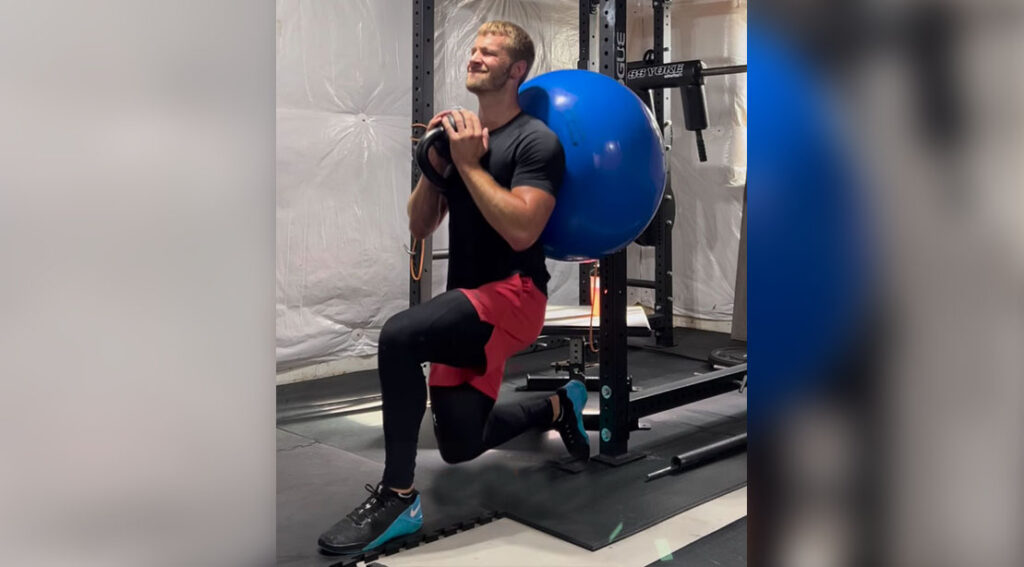[ad_1]
The leg press gets a lot of love and hate.
On the advantage side is the fixed range of motion, and your stable trunk takes core stability out of the equation. These two factors allow lifters to move massive weights. The fixed ROM and increased stability are a godsend for lifters who suffer from joint pain or whose back doesn’t like a barbell anywhere near it.
On the hate side, it’s more of an ego thing.
The leg press is not a barbell deadlift or squat, and how is it ‘functional’ in real life? Who sits down at a 45-degree angle and presses weight up? You don’t have your feet on the ground, so doing it has no bearing on performance. I feel the leg press has its place, and when used as an accessory exercise, it will improve lower-body strength and directly carry over to your performance in and outside the gym.
If you love the leg press and can’t access one, Dr. Justin Farnsworth has the exercise for you. Farnsworth, Doctor of Physical Therapy (DPT), Board Certified Sports Clinical Specialist (SCS) with 20 years of coaching experience, has developed this excellent alternative: the stability ball back supported split squat. Strap yourselves in; you’re in for a real leg-day treat.
Stability Ball Back Supported Split Squat
“The leg press feeds stability, giving us a greater output on moving load. This is massive for quad strength, the biggest predictor of function (you need it to walk, get out of a chair, and navigate stairs) as we age. During the leg press, the vertical trunk specifically targets the quads as the primary mover, leaving little to no room to cheat.” explains Farnsworth.
Farnsworth has the perfect alternative for your quads if you haven’t access to a leg press or want some variety in your leg training. Enter the Stability Ball Supported Split Squat.
Dr. Farnsworth explains, “ This split squat variation requires minimal equipment that most people have access to if there is no leg press. The standing position allows us to interact with gravity in a more, dare I say, “functional” position because it mimics how we spend 70% of our time in weight-bearing position and allows for targeting muscle imbalance if one side is weaker than the other.
Like a leg press, it forces a vertical trunk and therefore, a quad-dominant position. If you want more glutes/adductors, you can stand on a box to create a deficit.”
How To Do The Stability Ball Back Supported Split Squat
Find your split stance position: Start in a 90-90 half kneeling position (knees and hips in line with each other) and then use a mark on the floor or a band placed at the front leg toe so the range of motion is repeatable. Pad the floor if needed.
Lean back: Place a stability ball on the wall/rack and lean into it with both legs on the floor. Your feet should be in FRONT of your hips.
Getting Into Position: Step back with the non-working leg and provide a slight toe touch. Maintain complete foot contact on the front with weight evenly distributed between the toes and heel. The back foot is like a kickstand to a bike- there to provide support and not fall, but not the main emphasis. 90% of your weight should be on the FRONT leg.
Create Tension: Use your pecs and lats to squeeze the weight in your hands (elbows down and together) to create more stability.
Set And Rep Suggestions: Dr. Farnsworth suggests performing this as an excellent accessory exercise on a lower body-focused day. For building muscle, eight to 15 reps per set focusing on a slow eccentric and a powerful concentric contraction works best. Good luck taking the stairs the next day after this one. Don’t say you haven’t been warned.
Set And Rep Suggestions
Dr. Farnsworth suggests performing this as an excellent accessory exercise on a lower body-focused day. For building muscle, eight to 15 reps per set focusing on a slow eccentric and a powerful concentric contraction works best. Good luck taking the stairs the next day after this one. Don’t say you haven’t been warned.
[ad_2]
Source link


